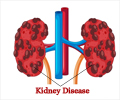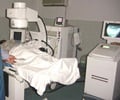Low-oxygen saturation in the blood can worsen chronic kidney disease due to a protein called - Hypoxia inducible-factor HIF-1.
A study from University of Pennsylvania School of Medicine reveals that low-oxygen conditions can worsen chronic kidney disease (CKD). Hypoxia-inducible-factor (HIF-1), a protein is active during Hypoxia(a condition when the kidney does not get enough oxygen).
CKD afflicts 20 million Americans who have hypertension, atherosclerosis, diabetes, and other conditions. The kidney has less oxygen reserves than other organs to start, and CKD is associated with less capillary blood flow, reducing oxygenation even further. As CKD progresses, kidneys become full of fibrous tissue and cannot filter wastes out of blood or regulate body salt. Eventually kidney dialysis, a form of renal replacement therapy, may be needed to carry out these processes. Ultimately, the clinical goal is to optimize treatment to halt or delay the progression of CKD by better understanding its molecular underpinnings."Fibrosis worsens when the kidney becomes hypoxic," states lead author Volker Haase, MD, Assistant Professor of Medicine, Renal Electrolyte and Hypertension Division. "We found that HIF-1 is more stable when oxygen is in short supply and that HIF-1 causes kidney epithelial cells to regress to a less-differentiated cell type. This transition is driven by HIF-1, a protein that turns on many genes that promote the synthesis of fibrous connective tissue, thus interfering with the kidney’s normal filtering function," says Haase.
The study was conducted using mice that had been engineered to turn off expression of HIF-1á (a critical subunit of HIF-1) in their kidneys. One kidney from each mouse was put under oxygen stress by obstructing the ureter, and the other kidney served as a control. As long as HIF-1a was silenced, fibrosis was reduced in the oxygen-deprived kidney. This demonstrated that HIF-1 promoted the fibrotic process under reduced oxygen conditions.
Kidney biopsies from patients with diabetes who also suffer from CKD were tested for HIF-1á levels. Normal kidneys had almost no HIF-1á, whereas kidneys from diabetics had moderate to high expression of HIF-1á. "This observation, along with increased expression of the genes controlled by HIF-1 in diseased kidneys in mice, shows that HIF-1 is the molecular link between hypoxia and CKD in humans as well as rodents," says Haase.
The next step is to test other models of CKD and identify additional molecular targets of HIF-1 that can promote fibrosis. “We also hope to study the inflammatory response to hypoxia in the diseased kidney,” concludes Haase. “We already know that some pro-inflammatory proteins are stimulated by hypoxia.”
Some day, it may be possible to use HIF-1 and HIF-regulated genes as molecular markers to identify those patients that are at high risk for rapid progression of CKD requiring dialysis.
Advertisement
SRM /J











